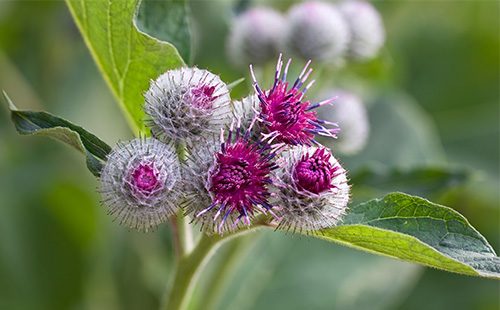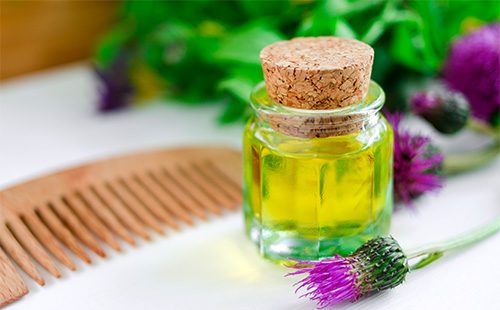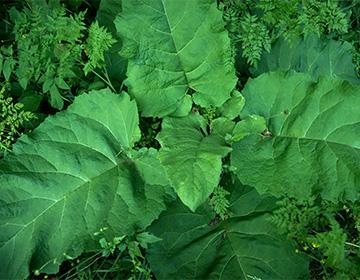The content of the article
Greater burdock (ordinary) has long been valued by folk medicine. Doctors began to use the plant after its biologically active composition was discovered by science, and the therapeutic properties have received evidence. Other common plant species - felt and small - are not prepared as pharmaceutical raw materials.
Botanical characteristic
It grows in homes, along roadsides and in deserted areas. You cannot collect at landfills and roads. For searches, it is better to choose clean beams and forest edges.
It is found throughout Russia, except for the northern regions. It is believed that the plant was brought to us from the Asian part of the continent during the Tatar-Mongol invasion. Then it migrated to Europe, and later to North America.
It is transported over long distances, as the seeds attach to the fur of wild animals. Over time, even one plant can form thickets, constantly sowing soil.
It is easy to recognize mugs ordinary and felt - they are similar in appearance.
- The stalks. The plant can reach up to 2 m in height. Stems erect, branching at the top. The surface is ribbed, often pubescent. Sometimes pubescence is called cobwebby, since the glandular hairs are very thin and tightly intertwined.
- Leaves. In the first year of development of an individual, only a basal rosette of large petiolate leaves with a solid edge appears. The upper part is naked, with a deep green hue. Lower - bluish, often pubescent with cobweb hairs. The leafy stalk appears in the second year. Leaves are placed alternately, petioles become shorter to the upper part. The apical foliage is dark green, often glossy, bare even from below.
- Flowers. A distinctive feature is spherical bisexual flowers with scaly hairy bract. The color of the tubular flowers is purple, can be with bluish or purple hues. (On a small burdock, the flowers are collected in the likeness of brushes).
- Fruit. Develop after flowering. They are represented by brown seeds. Thanks to the villi, they scatter well in the upper part. They cling to human clothing and animal hair.
- Ground part. All plant species have a rooted root system. Its base is a powerful, fleshy and juicy root, penetrating into the soil about 60 cm. The surface is furrowed, and the bark is yellowish-brown. Many small laterals depart from the main root; they do not represent medicinal value.
Harvesting raw materials
As a medicinal raw material, traditional medicine uses all parts of the plant. Moreover, both in dried and fresh forms. Harvesting begins in the third decade of June and can continue through September.During this period, it is possible to collect leaves, flowers, seeds and underground parts.
Roots
The roots can be harvested in the first year of life - in the fall. According to ancient herbalists, it is in such raw materials that the maximum benefit is concentrated. If you could not dig it in the fall, this can be done in the spring. It is necessary to catch it before the stem is formed. In the future, raw materials lose their healing qualities, since most of the useful substances are spent on the development of the aerial parts.
- Collection. The plant is dug from all sides as deep as possible. After that, the root is extracted by pulling strongly on the base of the outlet. Shake off the soil.
- Training. The aerial part is removed, thin roots are torn off. The rod is washed under cold running water. Peel off the bark, cut lengthwise into plates. They are cut into pieces 10 cm long.
- Drying. Lay out the plates on a pallet covered with parchment. Dried in natural conditions under a canopy, but with good ventilation. Turn the mass over regularly.
- Storage. We need dense wooden boxes or linen bags. It is better to use blanks in the first two years.
Leaves
Leaves can be collected from a basal rosette or pluck young greenery from the stems.
- Collection. Cut with scissors or secateurs almost at the base.
- Training. Sort out, discarding damaged and insect dried parts.
- Drying. Lay out in one layer on a pallet. Place it under a canopy with through ventilation. Dried to brittleness.
- Storage. Save raw materials in linen or paper bags in a dry and dark place. Suitable for two years.
Composition
The highest concentrations of biologically active substances are concentrated in the root.
Leaves are valuable for their vitamin content. Young greens can even be added to spring salads for the prevention of vitamin deficiency and loss of strength. Seeds, in which there are many nutrients, fatty oils and natural steroids, are used in medicine and cosmetology.
The underground part has great nutritional value. In addition to pharmacologically active substances, it has digestible proteins and sugars. They have a positive effect on energy metabolism in the cells of the body, improve lipid metabolism and enzymatic activity. Other useful compounds.
- Inulin. Refers to polysaccharides with biological activity. Strengthens the immune system, normalizes metabolic transformations, stimulates the activity of enzymes, regulates the absorption of mineral salts. Also, hepatoprotective and antitoxic actions are characteristic of it. The substance is capable of cleansing lymphatic tissue.
- Essential oil. It is also called bardan. Provides anti-inflammatory activity of the plant, the ability to eliminate pathogenic microorganisms - bacteria, fungi, viruses. It stimulates the immune system.
- Fatty acid. Of these, the root contains palmitic and stearic. Provide a mild decongestant effect, restore lipid metabolism, prevent an increase in blood cholesterol. They also increase the body's resistance by strengthening cell membranes, participate in the synthesis of hormones, and are necessary for the normal functioning of nerve fibers.
- Organic acids. In the burdock there is coffee, apple, lemon. With their help, the plant positively affects metabolic processes, has choleretic and diuretic properties, stimulates intestinal motility, and prevents the growth of pathogenic microflora on its membranes. It has an anti-febrile effect.
- Sterols Thanks to them, the phyto-drug regulates the functioning of the endocrine glands, normalizes the production of insulin and other hormones that regulate the metabolism. The plant lowers cholesterol, positively affects the state of the vascular walls, normalizes their permeability and permeability of the lumens.
- Bitterness. They have secretory properties, improve the functioning of the digestive glands, increase the acidity of gastric juice, the activity of enzymes. With their help, peristalsis of the gastrointestinal tract is normalized, excessive gas formation and putrefactive processes in the intestine are prevented.
- Tannins. They have astringent and anti-inflammatory effects in case of damage to epithelial tissue, normalize blood viscosity, and improve its rheological properties.
- Proteins The protein substances of the plant contain amino acids that are important for the human body. This is due to the general strengthening and immunostimulating effects of the plant, its ability to accelerate metabolism, to establish the processes of enzymatic synthesis.
- Minerals and vitamins. With their help, the plant regulates mineral metabolism, eliminates edema, improves the formation and facilitates the excretion of urine, simultaneously providing an anti-inflammatory effect.
The plant has antitumor and antioxidant properties. Not only prevents the development of oncological processes, but also actively participates in their elimination.
The leaves of burdock are rich in tannins and organic acids. They revealed large concentrations of vitamin C, flavonoids, as well as a natural antimicrobial compound - chlorophyll. Carotenoids and mucus cause regenerative properties.
Seeds have a beneficial effect on the liver, not only as sources of lipotropic substances, but also biologically active arctin glycoside.

Healing properties
Burdock root in folk medicine is used as a cleansing and detoxifying agent. (Previously, even severe poisoning, as well as bites of poisonous snakes, were healed with his help). Hoods are used for preventive cleaning of the body, eliminating unpleasant symptoms after insect bites. Burdock is also useful for alcohol poisoning. Also, the plant has the following medicinal properties.
- Supports ODA Health. Due to the regulation of mineral metabolism, it reduces the symptoms of gout, normalizes the mineralization of bone tissue, contributes to its normal growth, and also prevents rickets and osteoporosis. Anti-inflammatory properties are relevant for arthritis, rheumatic joint damage, age-related changes. For the treatment of joints, the plant is used internally and externally.
- Heals the kidneys. It normalizes the formation of urine, improves its outflow, relieves inflammation from the tissues of the kidneys and epithelium of the urinary ducts, and prevents the formation of calculi.
- Regulates the digestive tract. It treats chronic lesions of the organs of the gastrointestinal tract, prevents exacerbation of ulcers and gastritis. Stimulates the work of the pancreas and gall bladder, contributes to the normal outflow of bile, provides prevention of the formation of gallstones. Also relieves inflammation in the intestines, useful for hemorrhoids. The detoxification and antiparasitic properties of burdock are relevant in the treatment of helminthic invasions.
- Eliminates a fever. Lowers temperature, eliminates body aches, weakness. Helps with bronchitis and pneumonia. In the form of rinses, it treats tonsillitis, tonsillitis, pharyngitis, stomatitis.
- Normalizes metabolism. Promotes weight loss. Cleanses tissues and organs, as well as lymph. Removes excess fluid. It stimulates the natural production of insulin, and also improves its effect on body cells, which is important for diabetics.
- It treats women's diseases. Used to regulate the cycle, normalize the production of female sex hormones. Assign with ovarian cysts, myoma, malignant lesions of the genitals.
- Eliminates tumors. Helps in the early stages. In addition to gynecological diagnoses, they are used against cancer of the stomach, esophagus, intestines. The therapy is under the supervision of a doctor and along with classic anti-cancer agents. It also eliminates cysts and benign neoplasms of any localization, prevents malignancy of cells.
- Heals the skin. All dosage forms can be used externally.They treat hemorrhages and bruises, joint swelling, muscle pain and neuralgia. Juice and extracts are active against fungi, infectious lesions, erysipelas, abscesses, boils. Burdock preparations are recommended for psoriasis, eczema, pressure sores, trophic ulcers, various dermatitis and allergic rashes.
Prescription Drugs
In the pharmacy you can buy dried raw materials, fees, herbal teas and dietary supplements with burdock in the composition. Before using the drugs inside, it is better to consult a doctor or an experienced herbalist. Cosmetics based on burdock can be used without fear - they usually do not contain allergens, act gently on the skin of the body and head. From the raw materials at home, they independently make medicines.
Decoction
Features Prepared from all parts of the plant. From the roots - to cleanse the body and as a choleretic agent, from leaves - with a stomach ulcer, from seeds - for hair and inflamed skin. The proportions are always the same. For internal decoctions, take one tablespoon of raw material, for external - two.
Preparation and use
- The required amount of medicinal raw material is placed in a brewing container with a lid.
- Pour a glass of boiling water, mix with a spoon, cover the container.
- Boil over low heat for a minute.
- Remove from the stove, leave to infuse for 40 minutes.
- After filtering, internal decoctions take a quarter cup three times a day. Concentrated external products are used for lotions and compresses.
Tincture
Features It is used internally for all pathologies for which burdock is active, and also as a prophylactic. You can also apply externally - to rub inflamed joints, painful muscles, lower back with radiculitis.
Preparation and use
- 20 g of dried root is placed in a container for preparing tinctures.
- Pour raw materials with a glass of clean, high-quality vodka.
- Leave for two weeks in a dark, cool place.
- After the expiration of the infusion, the filter is filtered.
- Take orally 20-30 drops three times a day for half an hour before a meal.
Butter
Features Helps strengthen hair, stimulates hair growth. The tool is also rubbed into the affected joints and sprained ligaments. Used for healing wounds, minor burns, frostbite, scratches.
Preparation and use
- 20 g of crushed root powder is poured into 100 g of pure olive oil.
- Leave the container in a dark place for at least a month.
- After the time of infusion, the oil is filtered through several layers of gauze, stored in a dark place.
- Use externally.
The juice
Features It is indicated for liver pathologies, decreased immunity, metabolic disorders, for the prevention of cancer. But you need to use it carefully - they are bred before taking it. Also applied to skin lesions, added to ointments and care products.
Preparation and use
- To make juice from the leaves, the raw materials are passed through a meat grinder, and then squeezed through cheesecloth.
- Juice from the roots is also squeezed also through cheesecloth, previously crushed. But then the remaining meal for three hours is poured with water (1:10), and after straining, mix with pure juice.
- Both versions of the drug are consumed in a tablespoon three times a day, dissolved in a small amount of water.
Contraindications
Contraindications include:
- periods of pregnancy and lactation;
- childhood;
- individual sensitivity.
Allergic reactions can occur with skin rashes or dyspeptic disorders. With such symptoms, you should refuse to use the plant in any form.

Reviews
Ladies ... the result the first time ... this tool is ideal for people who want to give their hair a little stiffness and volume. The hair immediately feels thicker to the touch, it feels as if this broth enveloped each hair and made it 2 times thicker, the effect is even noticeable when braiding hair into a pigtail.
The hair at the roots is generally so stiff and a noticeable bulge is kept. Only the main thing is not to overdo it with the product, and because of the stiffness, the hair is a little more difficult to comb. I think if you do this procedure all the time, then you can really achieve ideal results, because there are so many useful things in the burdock. But as far as I know from the recipes of grandmothers, burdock roots are suitable only for owners of normal and oily hair, although I may be mistaken.
Nina, http://www.woman.ru/beauty/hair/thread/4201023/
Burdock thing! Dad had burns of 2-3 degrees. Two weeks later, they left the hospital, because they said that now only dressings remained for him. And with burns it’s tin, because under the bandages everything begins to fester, and the treatment is the treatment with medications, and each time, like dressing, they just tear off the dried flesh and bandage it again, the result is terrible deep scars.
Therefore, my dad left the hospital for a receipt, his grandmother soaked the bandages with a mixture of lime water and oil ... there were many festering wounds under them, medicines that all the garbage was prescribed in the hospital. Grandmother here remembered the burdock, applied a couple of days, all the pus sucked the burdock, there were simply wounds that were already healed with ordinary honey. means. There were fewer scars than usual, and Dad recovered faster than doctors predicted !!!
Inna, https://www.baby.ru/popular/lopuha-korni/
Hello! I found a suspicion of a polyp being treated, a good friend of my mother advised me to make and drink tincture from the roots of burdock. He says that it’s a very good remedy, especially on the female side, and of course, for greater persuasiveness, he gave several examples to whom this tincture helped a lot.
At that time, we were in the country, so digging up the root was not a pleasure. Mom made me a tincture, settles for 18 days, 10 days to drink, 10 breaks. today was the first day, three times a day, in a tablespoon. I admit I never tried such horror ... I don’t even know what to compare with. (tincture on vodka).
Nastya https://www.baby.ru/blogs/post/416469305-260920923/
I always dreamed of long hair, and I was always not happy with the length ... That's all I did with my hair. Right now there are very few of them. All summer and autumn, they fell terribly. Shreds, locks ... I tried everything. And only the burdock root saved me this one of this problem (not completely of course, but the effect was noticeable). I do not use it constantly, but a month later in a month.
sarry, http://irecommend.ru/content/volosy-bystro-rastut-i-bolshe-ne-vypadayut-zasluga-kornya-lopukha-podrobnyi-fotootchet-prigo

